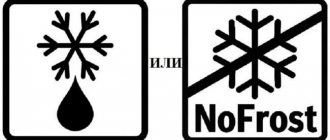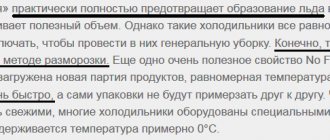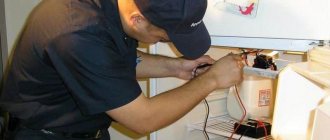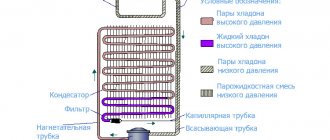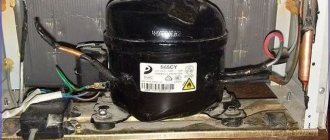No-Frost literally translates as “without frost.” And indeed, during normal operation, the user does not see snow and ice inside the refrigerator. In fact, of course, any cooling process leads to the formation of frost on the evaporator. However, it defrosts periodically based on a sensor signal or a mechanical timer. It is due to this process that it seems that snow does not freeze at all in No Frost refrigerators. To understand how this type of equipment works and whether it needs to be defrosted, let’s briefly look at the design of such refrigerators.
Refrigerators with No Frost are divided into two types: full No Frost - Full No Frost and partial - Free Frost.
Refrigerators Full No Frost
In full no-frost, the evaporator is located in the freezer on the back wall and cools both chambers: the refrigerator and the freezer. You won't be able to see it when you open the door, since it's hidden behind the back panel. There is a hole near the evaporator - this is a system of air channels. Through them, cold air enters the refrigerating chamber, and this is how it is cooled. The flow of cold air and, as a result, the temperature in the refrigerator compartment is regulated by a special damper. It shuts off its supply as soon as the temperature in the refrigerator reaches the set temperature.
Behind the evaporator there is a heating element - a defrost heating element. During operation of the compressor, ice forms on the evaporator. Periodically, based on a signal from the defrost sensor or timer, the heating element turns on: it melts the ice. The water goes through a special drainage channel into a bath located on the compressor and evaporates there.
Summarize! Thus, no ice forms at all in the refrigerator compartment, since the chamber is cooled by cold air from the evaporator of the freezer. And the snow in the freezer regularly thaws when the heating element of the NoFrost defrosting system is turned on.
General recommendations
During the defrosting process, you should rely on the following recommendations:
- Do not defrost in hot weather. Temperature surges negatively affect the operation of the compressor.
- It is necessary to carefully study the instructions.
- The equipment should be started no earlier than 12 hours after shutdown.
Some models provide convenient defrosting of individual chambers. You can wash the freezer first, and then the other compartments.
Convenient defrosting of individual chambers
Refrigerators Free Frost
As for models with “partial No Frost”, the structure of the freezer compartment in them is completely similar to Full No Frost refrigerators. And for the refrigerator compartment there is a separate “crying” evaporator. It is located behind the rear wall and cools the refrigerator compartment. Defrosting of the evaporator also occurs automatically, but unlike the evaporator of the freezer compartment, it defrosts naturally while the compressor is resting due to the positive temperature in the refrigerator compartment. During the defrosting process, droplets of water may be visible on the back wall of the chamber. This melts the frost formed on the evaporator and back wall during cooling. Drops of moisture flow into the drainage hole and are discharged through the drain channel into a bath on the compressor, where they evaporate. It is because of the formation of water droplets on the rear wall during defrosting that the evaporator of the refrigeration compartment is called “crying”, and the defrost itself is called drip defrost.
Summarize! So, in the freezer, the ice on the evaporator is regularly thawed by turning on the No Frost defrost heating element. And in the refrigerator compartment, frost melts naturally while the refrigerator is resting, since the temperature in the compartment is positive. Therefore, the maximum that a user can see in a working FreeFrost refrigerator is frost on the back wall in the refrigerator compartment, which automatically thaws and turns into droplets of moisture. There is no question of blocks of ice or a “fur coat” that would need to be defrosted.
Thus, in both types of refrigerators with No Frost, the device itself and the operating principle of the equipment negate the need for manual defrosting. And yet, on the Internet you can find many articles in which they write that No Frost needs defrosting. Is it so?
Defrosting process
Defrosting refrigeration equipment is best done in cool weather. It is better to leave the shutdown for the evening, so that the device can work again in the morning.
Defrosting process
Preparatory stage
Before defrosting, the following activities are carried out:
- Turning off the equipment.
- Emptying the refrigerator of all products.
- The doors must be opened.
- All provisions must be sorted out and spoiled and rotten products must be selected.
- Removable elements must be dismantled.
- Inside the compartments you need to lay out fabrics that will absorb moisture.
To gain access to the rear of the cabinet, the equipment must be moved away from the wall.
How to defrost
It takes two days to completely defrost. During this time, the frost will disappear even in hard-to-reach corners of the equipment. The unit can defrost on its own, but at this time you need to clean the equipment:
- To clean the ventilation holes, you need to prepare a solution of two liters of water and three tablespoons of soda.
- Using the same composition, you can wipe all internal surfaces and drawers.
- Use a toothbrush to clean rubber seals.
- External surfaces are treated with a product that does not contain abrasive components.
- The back surface can be cleaned with a vacuum cleaner.
Additionally, all surfaces are treated with an antibacterial composition. Before turning on the refrigerator, you must wipe it with a dry cloth.
Final stage
Only a well-washed and dry unit can be connected to the network. Then all the shelves, drawers and containers are put into place.
Is it necessary to defrost a No Frost refrigerator - dispelling the myths
Myth 1: A No Frost refrigerator needs to be defrosted once a year.
Above we looked at the operating diagram of No-Frost refrigerators. The ice in them defrosts automatically, so nothing can freeze anywhere in properly functioning equipment. We came across No Frost refrigerators that worked properly for 10 years, and they were never unplugged from the outlet, much less defrosted.
RemBytTech craftsmen, who have more than 15 years of repair experience, officially declare: all that is required is No Frost - periodic wet cleaning. It is enough just to remove crumbs and debris, wipe the walls and shelves of the refrigerator: this will ensure not only a neat internal appearance, but also the absence of an unpleasant odor in the refrigerator compartments. Before cleaning, be sure to unplug the refrigerator.
Myth 2: after cleaning the No Frost refrigerator from contamination, you cannot immediately turn it on; at least 1 hour must pass from the moment it was turned off.
This myth has some basis, but it is outdated. “Sofa experts” write that the reason lies in equalizing the pressure in the system. The logic is this. When the compressor is running, the freon in the condenser is under high pressure, and after turning off the motor, the pressure in the system cannot instantly equalize. In particular, increased pressure will remain for some time at the outlet of the compressor (in the discharge tube). The motor is not designed to start under such conditions: the starting torque may not be enough to move the piston against the pressure, so the compressor may jam. Blocking the motor shaft when power is supplied to the compressor, in turn, is considered a dangerous condition, since the motor windings are overloaded and can burn out. Then the compressor will need to be replaced.
If we talk about old refrigerators, then there is indeed a possibility of the situation developing according to such a scenario, which leads to a “wedge” of the motor. But only if you turn it on almost immediately. If you let the refrigerator sit for at least 5-10 minutes (and it is unlikely that wiping will take less time), no problems will arise.
Modern models are even equipped with protective relays: after disconnecting from the power supply, it simply will not allow the engine to start immediately. This way, you can plug in your refrigerator immediately after cleaning. The compressor will only start when the system is ready to start safely.
How often should the procedure be performed?
A No Frost system refrigerator should defrost once every 10-12 months. Defrosting removes frost and cleans all surfaces. Periodic defrosting is a useful procedure for all models. A short stop in the operation of the equipment allows the system to rest. When you turn off the device, you can perform a full cleaning. If electrical networks often fail, then for preventive purposes, it is recommended to defrost once every four months. It will take approximately 12 hours to defrost the equipment.
Important!
If a large amount of frost has formed in the no frost refrigerator, it is worth checking it and finding faults. The problem may be a leak in the seal.
If there is ice frozen in the refrigerator with No Frost
Often, when No Frost owners find ice in the refrigerator, they resort to the traditional method of removing it - defrosting. As a rule, after this procedure the equipment works properly for some time. This is what gives rise to the myth that No Frosts need to be defrosted. In fact, if ice begins to form in a refrigerator of this type, it is a malfunction. And no matter how much time you defrost your No Frost, the breakdown will not go away on its own.
The most common reasons for this “behavior” of equipment is a failure of the evaporator defrost system or a clogged drainage channel. Let's talk about them in detail.
Failure of the No Frost evaporator defrost system
Every second call to the RemBytTech workshop with a breakdown of the No Frost refrigerator is associated with a failure of the defrost system. This causes the evaporator to become filled with ice. But since it is hidden under the panel, the user usually does not see it or does not notice it right away.
In Full No Frost models, the problem is most often detected when the cooled air supply channel to the refrigerator compartment freezes and it stops cooling. In Free Frost refrigerators, the refrigerator compartment operates as normal, and users begin to suspect something only when ice begins to form on the back wall of the freezer. In both cases, the refrigerator compressor turns off less frequently than usual.
Complete defrosting of a refrigerator (within 12 - 24 hours) with a failed No Frost defrosting system helps to normalize the operation of the equipment for a while. But after 1-2 weeks, ice forms on the evaporator in the freezer again, and the same problems arise.
If this is how your No Frost behaves, you don’t have to worry about constant defrosting, you just need to repair the defrost.
Malfunction of the No-Frost defrost system - from 2900 rubles.
A breakdown of one or more defrosting elements has occurred. The following may fail:
- thermal fuse;
- defroster (sensor that activates defrosting);
- defrost timer;
- Evaporator heating element.
Signs
The evaporator in the freezer is frozen, and ice may have formed on the back wall. The compressor starts frequently. The temperature in the freezer is negative, but higher than normal (for example, -14°C instead of -18°C).
In refrigerators with full No Frost, the refrigerator compartment does not work. When completely defrosted, the refrigerator starts to work normally, but after 1-2 weeks the situation repeats.
How to fix
Replacement of failed elements of the defrost system.
No Frost freezer drainage channel clogged
Normally, during defrost, water from the evaporator flows through the drainage channel into a reservoir located on the engine, and evaporates from there. If the drain tube is clogged, water flows into the freezer, accumulates at the bottom and freezes there. And sometimes it even leaks onto the floor under the refrigerator. After defrosting, such a refrigerator works properly for some time, but since the water has nowhere to go, ice forms again.
If your refrigerator behaves this way, check the patency of the drainage channel. To do this, remove the back panel of the freezer to get to the drainage hole and pour about half a glass of water into it. If water does not appear in the bath on the compressor, but stands in the drainage channel or spills into the freezer, it means the drainage channel is clogged.
When you cannot remove the back panel in the freezer, behind which there is a drainage hole (it is frozen by a snow coat), first defrost the refrigerator and only then check it.
Clogged drainage channel of the freezer compartment - from 1000 rubles.
When clogged with crumbs and dust, the channel stops passing water. As a result, it accumulates and freezes at the bottom of the freezer.
Signs
There is ice frozen on the bottom of the No Frost freezer. There is water under the refrigerator.
How to fix
It is necessary to clean the channel and remove the blockage. Using a syringe, the canal is washed with warm water. If the water does not pass, the refrigerator is completely defrosted (from 12 to 24 hours), and the rinsing with a syringe is repeated.
In severe cases, when the above steps did not help, the channel is carefully cleaned using a cable of suitable diameter.
To be fair, we note that the appearance of ice in the freezer of No Frost refrigerators can be a consequence of other, more rare, breakdowns. You will find a complete list of faults that lead to the formation of ice and snow in the freezer in our article “Why ice and snow freezes in the freezer.”
Ways to speed up defrosting
There are several ways to help perform quick defrosting:
- The warm jet of the fan heater can be directed inside the chamber.
- Place a container of warm water in the refrigerator.
- Using a regular hair dryer.
- Placement inside the heating chamber.
- The inner walls can be sprayed with hot water using a spray bottle.
Most manufacturers do not recommend speeding up the procedure. This will extend the service life of refrigeration equipment.
What do we need?
Defrosting Samsung refrigerators does not require any special preparation. However, you will need to take time to wet the compartments and view their contents.
- A small container of water for preparing a soda solution;
- container for collecting melt water;
- dishwashing liquid or gel (replaced with washing powder or laundry soap shavings)
- Toothbrush;
- toothpaste;
- cleaning sponge;
- soft tissues;
- dry rags;
- antibacterial spray for the kitchen;
- gloves;
- Large bowl for soaking refrigerator parts.
If you do not have a large sink, the removable parts can be immersed directly in the bathtub after preparing a soap solution.
Useful tips
- After washing, do not turn on the refrigerator immediately, but after 15 minutes, when the surfaces are completely dry.
- Do not try to chip off ice build-up yourself or speed up defrosting with a hairdryer - it is better to wait for it to thaw on its own.
- In extreme heat, it is better not to defrost the refrigerator, so as not to damage it with a sudden temperature change.
- Do not use hard brushes or abrasives for washing - they may damage the coating of the device.
- Do not leave the No Frost refrigerator unplugged for less than 2 hours - this will overload the compressor.
All refrigerators require not only periodic defrosting, but also regular maintenance. Wipe down shelves and walls weekly, immediately clean up spills and wipe away stains to prevent unpleasant odors and the spread of germs.
Don't forget to check out how to defrost your Samsung No-Frost refrigerator.
How often do you defrost your refrigerator?
Once a yearMore often
How long does it take
It’s difficult to say how long it takes for a refrigerator to defrost, it depends on the model and the thickness of the ice layer. Modern household appliances with automatic defrosting systems must be defrosted within 2-3 hours. Older models may take longer, up to 12 hours. Many housewives left the refrigerator open at night. If the ice cover is large and the kitchen is cold, the process may take up to a day.
Sometimes the question arises of how to speed up defrosting. This is necessary if there is no time or there is a risk of food spoilage. But experts do not recommend interfering, as you may damage the equipment.
Important! Rapid defrosting is possible only if the rules and recommendations are followed, otherwise the equipment may fail.
Cleaning and odor removing products
Before defrosting and cleaning the refrigerator, decide which detergent to use.
• Topperr 3102 German antibacterial agent, environmentally friendly and non-toxic. Cleans, removes odors, prevents the formation of bacteria on refrigerator surfaces. It does not require water to use. The cleaner can be purchased separately or in a set with an odor absorber and two wipes.
• Italian cleaner Electrolux E6RCS104 cleans internal and external surfaces, effectively removes dirt of any complexity, does not require rinsing.
• Italian cleaner WPRO FRIR00 safely cleans stubborn stains, has a good citrus smell and does not contain chemical odors.
• Soda solution. Made from regular baking soda (one tablespoon per liter of warm water). A weak alkali dissolves dirt and cleans the surface.
• Acidic solution. For a liter of hot water you need to take three tablespoons of vinegar or lemon juice. Eliminates foreign odors and discolors yellowed stains.
When everything is ready, the refrigerator is defrosted and the melt water has been removed, remove all the shelves and drawers. They need to be washed, dried and dried separately. It is more convenient to wash large items in the bathroom, since they are unlikely to fit in the kitchen sink.
Rules
- Do not carry out the procedure of completely cleaning the household appliance and disconnecting it from the power supply for a long time if the room where the unit is located is too hot (cold). Temperature changes can negatively affect the performance of the compressor.
- If your refrigerator is equipped with two cooling circuits, then defrost the chambers one by one. A refrigerator with one circuit will have to be disconnected from the network.
- To speed up the defrosting process, use a hair dryer: a household device will help quickly dry the moisture inside the device and help equalize the temperature difference between the inside of the unit and the room.
IMPORTANT! It is strictly forbidden to remove frost using a knife or other sharp objects: you may accidentally pierce the chamber wall.
